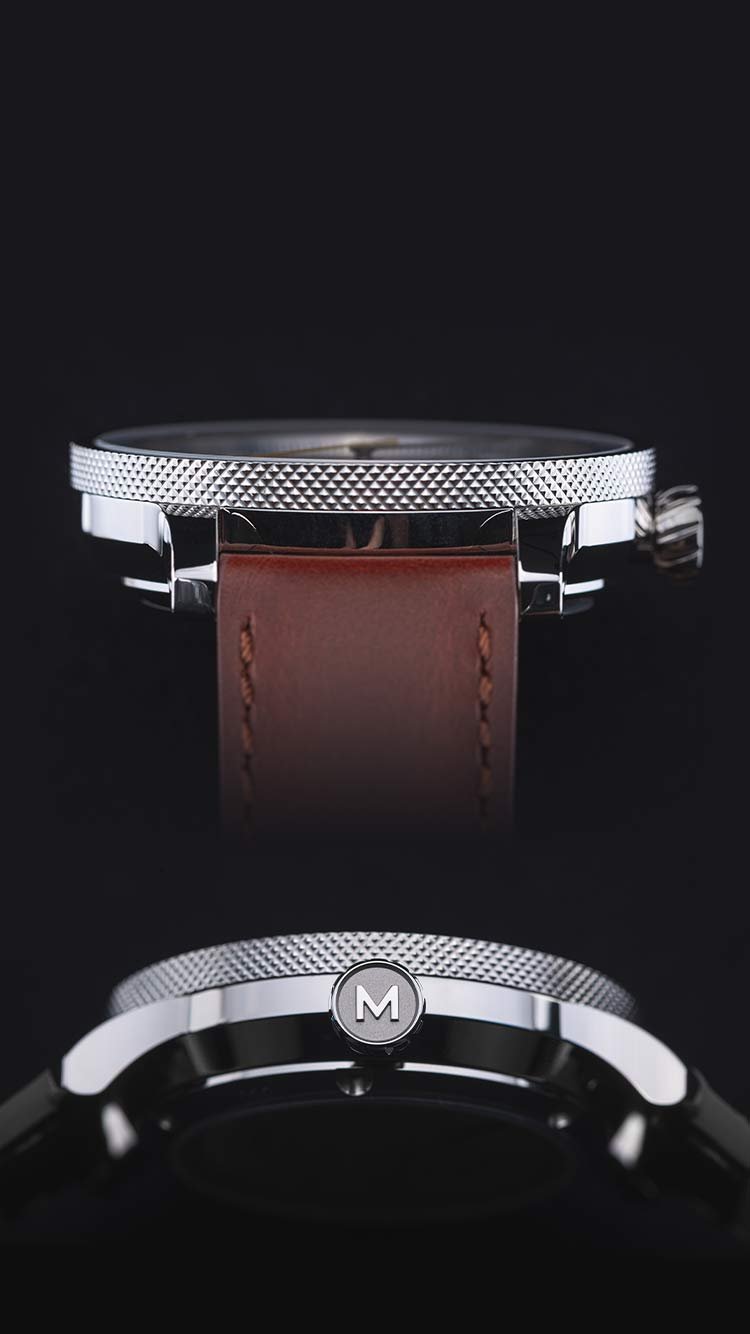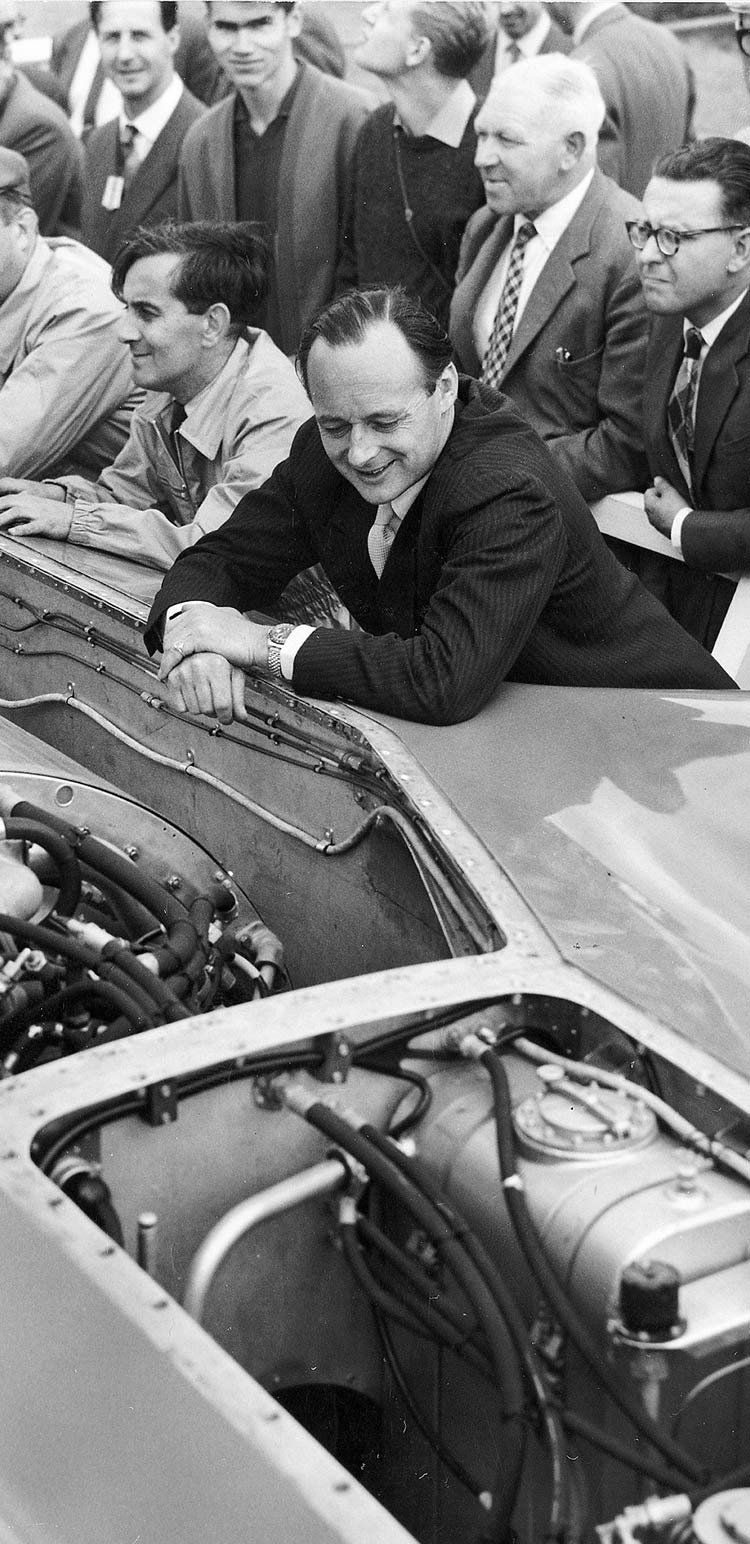
THE AUTOMATIC ERA
When we first heard that the original Coniston’s movement, the beating heart of any mechanical watch, was soon to be retired, we were shocked and saddened - we had planned to produce variations of the Coniston for many years to come. The design had resonated with fans of the Campbell Family legacy, speed records, dream chasers and motorsport enthusiasts all around the world. The movement was integral to that resonance for it looked, and worked, so beautifully. Hand crank movements usually have all the workings on display, but the movement we used - the 8N33 - was even more enchanting as it was skeletonised; the workings were revealed through machined bridges and base plates.
Our conundrum however was short-lived, for the 8N33’s automatic sibling, the 8N24, was equally captivating with its skeletonised frame and attractive specification. There was a slight difference though, in both shape and profile - the 8N24 was a little larger and wouldn’t fit the case of the original Coniston. We could either adapt the existing Coniston design to accept this new movement or build upon the expertise and experience gathered in the years since the original concept - we chose to build, develop and improve the Coniston design, and in doing so, open up a fresh chapter in the Coniston story
It’s fitting that this more mature, wiser Coniston, has again been designed in partnership with the Campbell Family Heritage Trust - celebrating with renewed enthusiasm the family’s history of speed chasing and dream capturing - with part of the proceeds of each watch going to support and promote the incredible legacy of the Campbell family.
To the future, and whatever it may hold.
OLIVER GOFFE - OPERATIONS & MARKETING
There’s a reason that Marloe is regarded as the most customer-loyal and friendly watch company around. It’s because of Oliver’s unwavering commitment to doing things the right way; he could be called a perfectionist, but we prefer to call him immensely pernickety.
GORDON FRASER - CREATIVE & PRODUCTION
Design through immersion is what makes each Marloe watch unique. A professional empathiser, Gordon highlights the spirit of pioneering, human endeavour and love of discovery in everything we do. A patriotic Scotsman, lover of pretzels and whisky. Maybe jazz too.
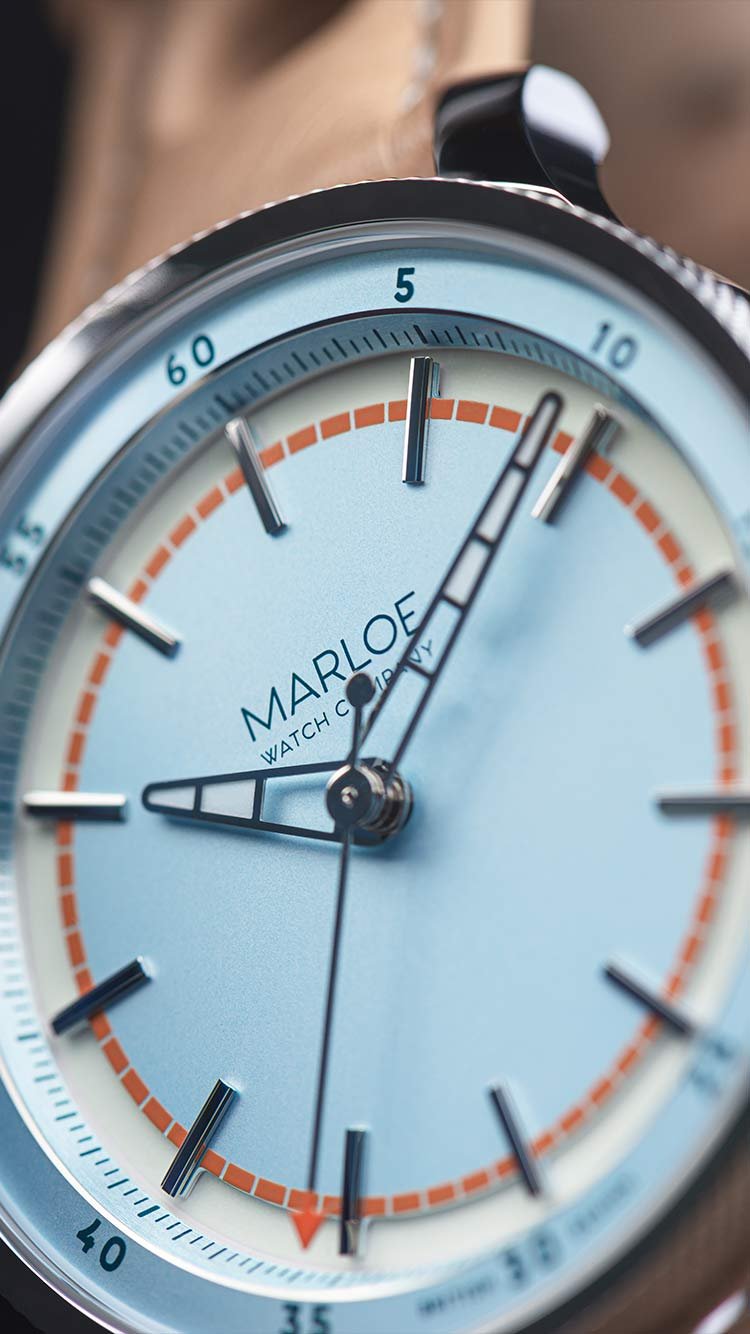
ITERATE. IMPROVE.
The Coniston always was a handsome fellow, with incredible dynamism of dial design and beautifully bespoke features - hands that resemble structural cross-sections, a glowing moat of illumination and striking refractions from the domed crystal.
We’ve had a lot of great feedback over the years following the launch of the Coniston, with much of the positivity focused on the dial and handset, as well as the magically deep dial design that draws the eye in, with its multiple layers, textures and colours.
It would have been sacrilege to ignore these elements when reconsidering the design for the new and improved Coniston, so we’ve tweaked them ever so slightly, with delicacy and perspective, to make them just that wee bit more resolved.
The dial and handset remain very much the same, only now we’ve added some subtle improvements - polished chamfers, extended batons and improved legibility - to enhance these foundation features.
However, the biggest change, as you’ll clearly see if you already own the original Coniston, is in the case design. So much has been learned in the intervening years from our other collections that we knew exactly how to make the case not just different, but slimmer, more interesting and more exciting.

EXCITING THE EYE
One of our biggest lessons from the past 4 or 5 years is the ability to use little details, almost imperceptible to the eye, that improve the aesthetic quality of a watch immeasurably. Small elements of polished steel or paints used in certain ways, with different finishing techniques, that enhance the user experience, adding contrast and legibility.
The Coniston Automatic has the same framework of dial construction as the original, using an outer bezel that sits just underneath the crystal and angles steeply downwards towards a moat of illumination - a white ring of luminescent material that glows brightly at night. The bezel on this iteration has a subtly polished chamfer on the edge that joins these two faces, and adds a little visual sparkle that oscillates constantly as your wrist moves.
In the centre of the dial the plateau has changed slightly too, with an overall larger diameter improving the surface upon which we can work. We’ve used 12 slightly longer batons on this iteration, which are polished and cantilevered outwards onto the luminous moat, improving legibility and uniformity through symmetry and balance. There’s also a contrasting edge detail unique to each colourway.
The hour and minute hands have remained very much the same - we were reluctant to change the style as they are synonymous with the Coniston design - especially the way the skeletonised construction reveals, when the hands overlap, the luminous segment from the hour hand through the minute hand - forming a single glowing hand. However, we have changed the running seconds hand to feature a counterweight and pronounced arrowhead - something we knew would improve this iteration of the Coniston and not distract from the design DNA.

OVER ENGINEERED
The case design is the biggest change for this new iteration of the Coniston, which was a result of the larger Miyota 8N24 movement and its automatic rotor. We wanted to re-think the design for the case not only to represent the insights gained over the past few years, but also to resonate with the history of speed records and the inimitable courage of Sir Malcolm Campbell and his son, Donald.
As such, we did a number of things. The first was to change the form of the case to allow for a more flowing, machine-like aesthetic. There’s now an unbroken line from lug to lug, curving around the case in one smooth arc. The angles of the caseback, when attached to your wrist, reduce the visual height of the watch, making for a superslim-wearing watch construction.
When you think of mechanical objects - engines, switchgear, caps and bearings - there’s always product semantics involved (e.g. operational requirements for grip and rotation). The knurling of metal is an easy way to offer mechanical grip and is used on knobs and switches inside cockpits old and new, for ease of use and clarity of operation - we’ve taken this concept and applied knurling to the case above lug level, affording a textural contrast from the polished metal below, enhancing the sentiment of being an instrument used in the world of speed record breaking.
And finally, we’ve switched from domed sapphire crystal to flat, in an effort to improve the legibility of the dial, regardless of lighting condition.

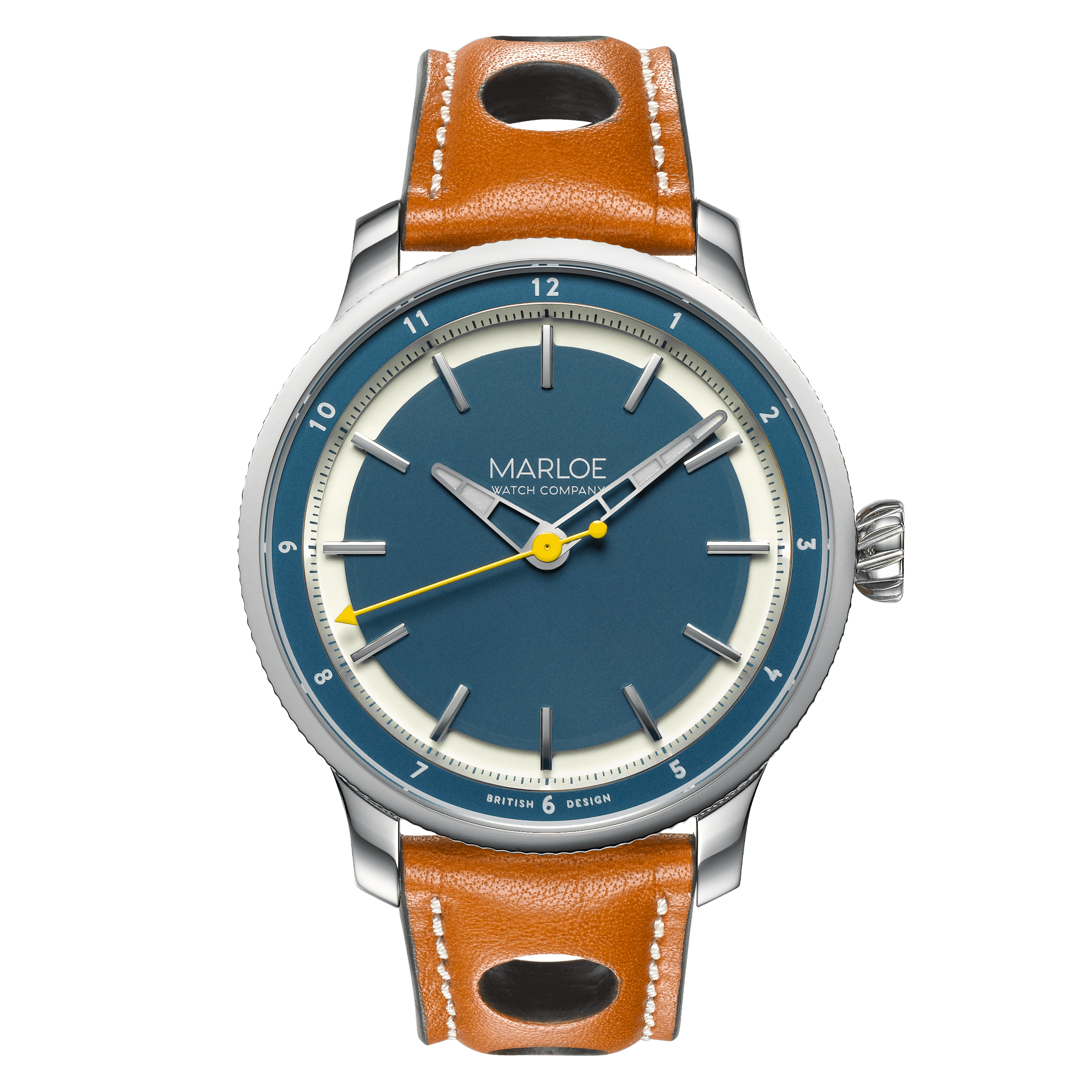
CN7
When we launched the original Coniston collection the Bluebird was our most popular model - not surprising really - the colour scheme, inspired by Bluebird K7 which Donald Campbell piloted across Coniston Water, is a visual treat.
There’s something really enchanting about the deep blue of the dial, coupled with the pop of yellow accents and silver-white trims that just sing in a watch face design. It almost does the work for us and in adapting the original design, we thought that it was time to celebrate another of Donald’s speed machines, the Bluebird-Proteus CN7 - a gas turbine-powered car that secured him the World Land Speed Record on Lake Eyre in Southern Australia, 1964.
We’ve improved the contrast of the chapter ring’s angled minute track, added in some metallic texture and added a subtle dark ring around the central plateau - all in the mission to delicately improve and adapt the original design. The dynamic depth is retained through the use of a multi-part dial construction and applied indices extending outwards over the moat of lume.
The hands float above the blue surface with their skeletonised structure combining to form one segmented hand, with the running seconds hand now featuring a counterweight, still coloured in the Bluebird accent yellow.
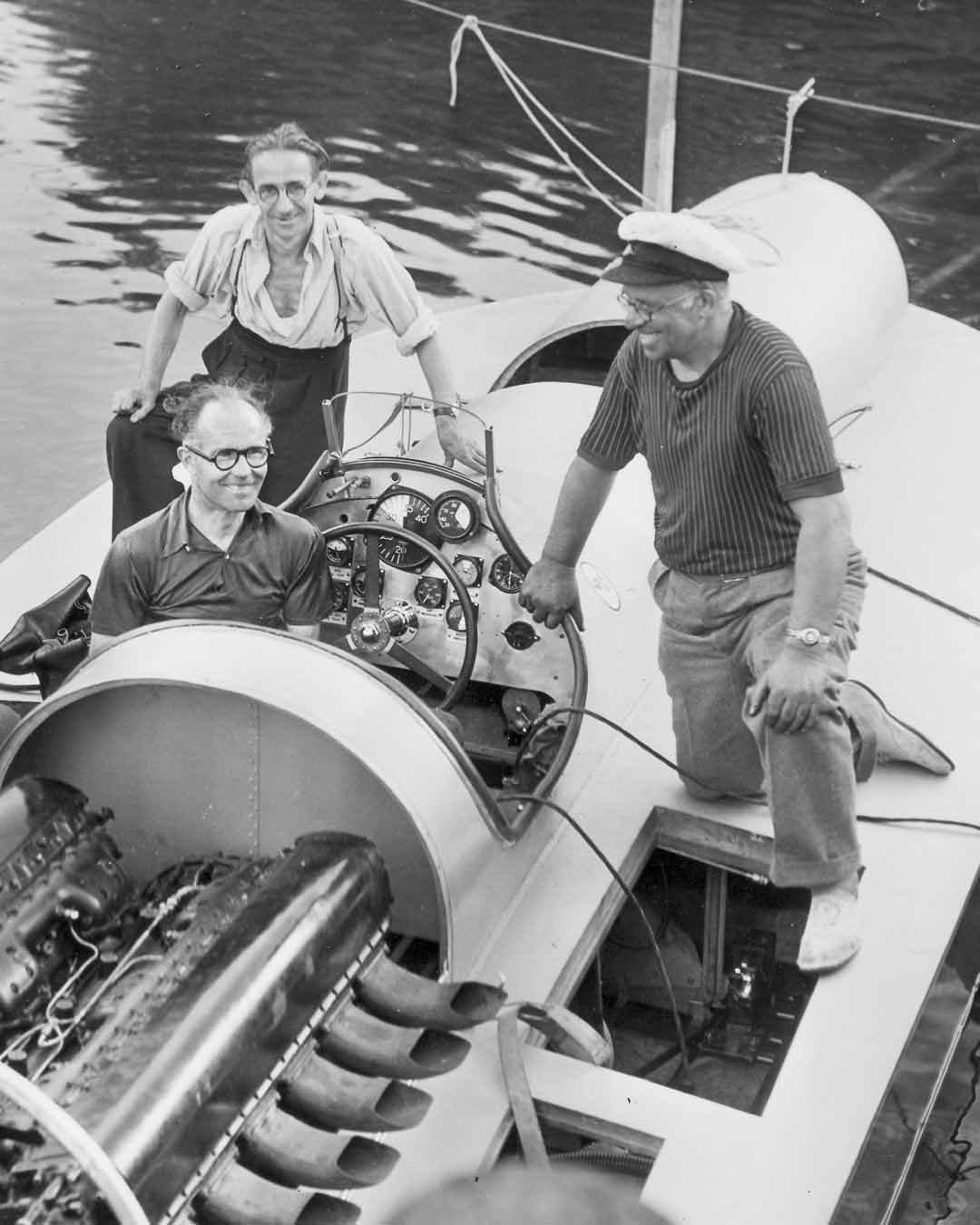

K4
Before the son, came the Father, and Sir Malcolm Campbell was a very inspiring father to have. The original speed master, the inimitable British record breaker and the charmer who captured the hearts and minds of the world. Sir Malcolm battled with land and water in pursuit of being the fastest human on earth, a feat he achieved numerous times in his various cars and hydroplanes.
The K4 is inspired by the hydroplane that delivered Sir Malcolm to his fastest speed ever achieved on water. Powered by a Rolls-Royce R 37-litre, 12-cylinder supercharged engine delivering a staggering 2,800 horsepower, the K4 would surge towards its 141.740mph speed record on Coniston Water on 19th August 1939. The K4 would go on to be retrofitted with a different engine in the hopes of smashing this record - the de Havilland Goblin turbojet typically fitted to aeroplanes; however, the retrofit resulted in no further records for the K4 but, owing to the extra fuselage required to fit this monstrous engine inside, inaugurate the nickname “The Coniston Slipper”.
The K4, with its white dial, grey accents and deep blue outer ring, draws inspiration from this incredible engineering marvel, and with the little pop of yellow, hints at what inspiration the K4, Sir Malcolm and the thrill of speed had on Donald’s water speed record aspirations.


TRACKDAY
Where speed is concerned, there are many facets of history in which to find inspiration. The Campbell Family legacy is one, but there are many more in all avenues of motorsport and speed chasing. When we were designing colourways for the Coniston range we opened up the shutters to include other iconic liveries.
From the unique Castrol liveries of the Toyota Corolla to the blue and gold “555” Subaru Impreza of Colin McRae, there are so many beautiful paint schemes to be inspired by, but the one that has taken us most firmly is the livery that raced at Le Mans during the early 1970s.
Sky blue and orange - a match made in motorsport heaven - it’s featured on many cars and boats competing in a multitude of events, from the original use on the Ford GT40 “Mirages” to more modern interpretations on Aston Martin’s V8s during “6 hours of Silverstone” to the most recent use on the McLaren F1 cars during the 2021 Monaco Grand Prix.
For our own Speedster, we’ve used a fully polished handset with just one accented tip - on the running seconds hand - in the same “marigold” orange as the original liveries. It’s a bit of a beauty, even if we do say so ourselves.

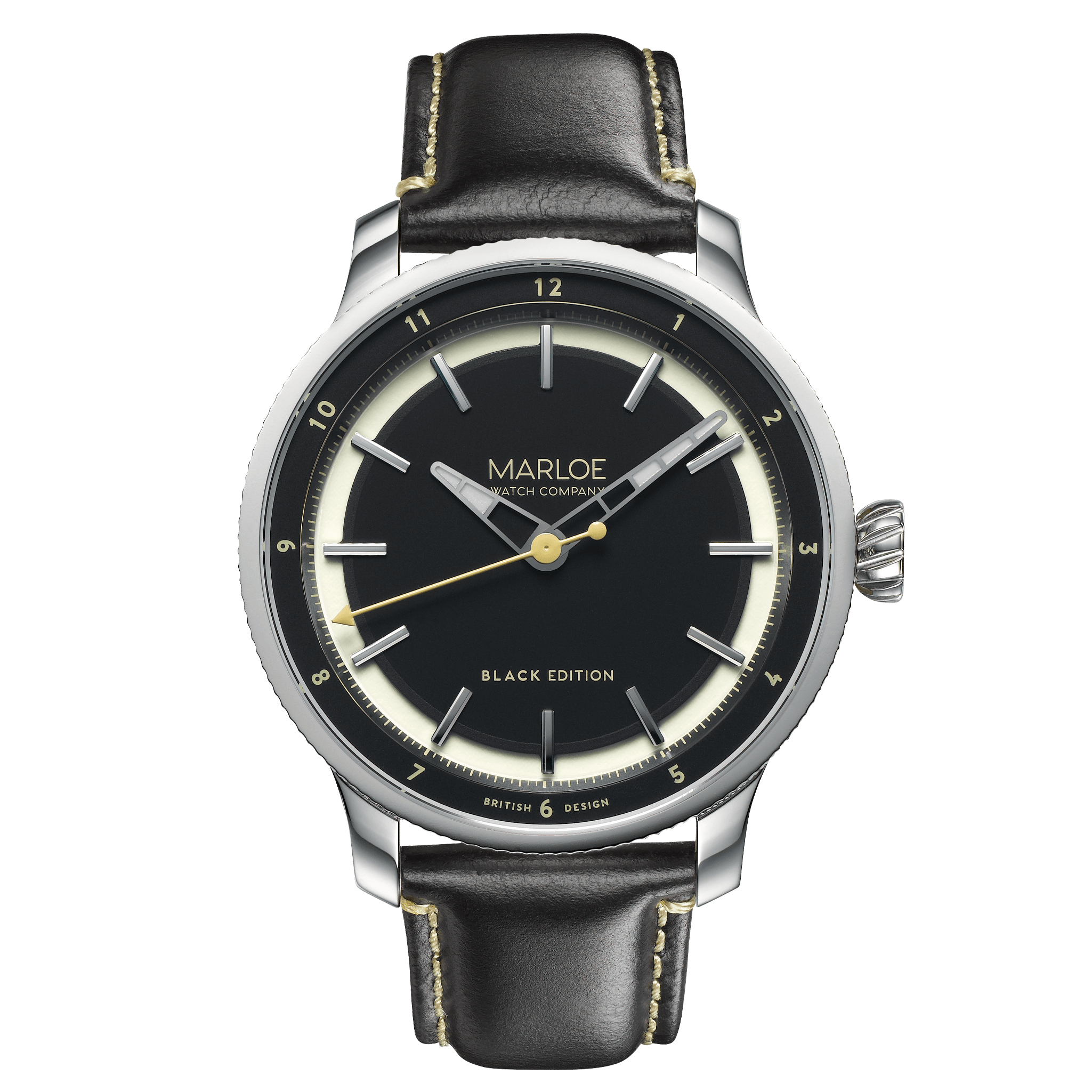
BLACK EDITION
What can we say about the Black Edition that hasn’t already been said? What started as a colourway on our Limited Edition Haskell has since developed into a stable of Black Editions, including the original Coniston, the Morar, Sceptre and now this, the newest iteration in the Black Edition sphere.
Keeping with tradition, the matte black base layer remains as does the faded tan printing for most of the dial treatment. However, we have added a dark grey metallic base for the minute track upon which faded tan minute marks are printed - it’s a simple yet clever contrast to bring the dial to life.
A polished handset with a faded tan running seconds hand, polished applied batons and the white moat of luminous compound adding its own accent, make this a fantastic, engaging dial that switches from the deepest black to a dark blue gradient, owing to the multiple coatings of blue anti-reflection coating on the flat sapphire crystal.
The tradition lives on.

ILLUMINEERS
The original Coniston featured luminous treatment that astonished, both with its brightness and longevity, but also with the reason it existed - to give maximum legibility at night.
The hands are generously filled with BG-W9, but it goes further, with the aeroframe hand design allowing a segmented approach. The hour hand has 2 segments filled. The minute hand has 3. Crucially though, the segments overlap allowing the hour hand to shine through the blank aperture of the minute hand. So no matter where the hands are you can always see them, even if they’re overlapping.
The seconds hand doesn’t lose out either, with the spectacular lume “moat” around the circumference of the main plateau, which throws the tip of the second hand into silhouette. It’s the small details that make the biggest difference.

GILT AS CHARGED
Tradition endures. The original Coniston featured a manual winding Miyota movement which, at the time, was underutilised. We loved it, and the gilt version blew us away. The warmth of the gold, the visual sparkle and the surprise when you see it for the first time meant that we had to use a gilt movement in the automatic version.
The 8N24 is a phenomenally robust movement and keeps your Coniston Auto charged for as long as you keep wearing it. We still get the same thrill seeing the 8N24 through the exhibition caseback as we did the first time.
OPERATING THE CONISTON AUTO
WINDING YOUR CONISTON AUTOMATIC
POWERING THE MOVEMENT
Inside your Coniston Auto is a Miyota 8N24 automatic mechanical movement. The movement is powered by your every move; each swing of the arm, each flick of the wrist or each step of your body injecting power into your Coniston.
Wearing your Coniston every day keeps it ticking. You can of course manually wind the movement and this can be done to top up every day or just to feel the movement between your fingers.
If you do want to manually wind your Coniston, feel free. Unlike our manual movement watches, the Coniston doesn’t come to a hard stop. You can wind forever and ever, for there is a clutch attached to the automatic rotor mechanism that prevents over-winding. So wind away and enjoy.
A fully charged Coniston will keep ticking for over 42 hours. Quite awe-inspiring considering it’s all down to the tiny mainspring, slowly uncoiling.
CHANGING ThE TIME & DATE
A SIMPLE PROCESS
The 8N24 is an automatic movement with 3 hands, and a very simple setting process.
Pull the crown all the way out, which will stop the seconds hand moving (hacking function) and allow the hour and minute hands to be set.
Progress the hour and minute hands around the dial. Simply set the current time and, once happy, push the crown all the way in again. This will kick the seconds hand into life again, showing that your watch is now accurate, on-time and under power.
SPECIFICATIONS
-
41mm diameter x 11.1mm depth
20mm strap width
Dual-texture bespoke designed case
Sapphire crystal with dual side anti-reflective coating
Multi-layer dial with applied indices & polished chamfer
Aero-structure hands
Hairline seconds hands w/counterweight & arrow tip
Luminous hands and dial perimeter
62g
10 ATM
-
Miyota 8N24 automatic mechanical movement
21,600 bph
21 jewels
Handwinding override capability
40+ hour power reserve
-20 ~ + 40 sec/day
Japanese Made
Hacking function
Parashock anti-shock
-
A mechanical movement, like a car engine, uses oils to lubricate the moving parts. Over time this fine grade of oil can become gloopy, causing your movement to lose accuracy. Every 4-5 years, think about having your watch cleaned and re-oiled by a professional - it’ll keep everything ticking along nicely.
The Coniston Auto enjoys a 2-year limited warranty which covers manufacturing defects. T&C - see our website.

All photos generously provided by the Mike Varndell Collection and the Campbell Family Heritage Trust.
Sir Malcolm Campbell and car at Pendine Sands, Wales
Donald looking over the Bluebird-Proteus CN7 at Goodwood
Leo Villa and team at Coniston Water with the K4
The cockpit of the Bluebird-Proteus CN7









